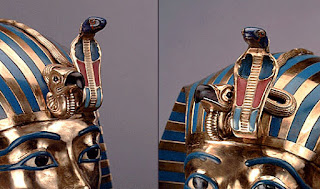Good day to you fine people, and welcome November! I hope everyone enjoyed their Halloween/Samhain, and that you are currently rocking Dia de los Muertos. I was fortunate to spend my weekend of spookery in New Orleans, surrounded by a plethora of drunken costumed revellers and haunted history tours. For a costume freak like me, it was divine just to people watch on Bourbon Street! I'm thinking of putting together a New Orleans edition of Costume History for next week, so stay tuned. But on to this week's location and time period:
ANCIENT EGYPT
Few cultures
are as easy to recognize as ancient Egypt.
Its people and their customs have left a distinct legacy for historians
of all disciplines. From their baffling
talents in architecture and extensive use of intricate hieroglyphics, to their
eccentric burial practises and beliefs in polytheism, the ancient Egyptians
have provided a treasure trove to spark our imaginations and inspire us to
learn more. That, and the way they
dressed was pretty neato.
Located in
northeast Africa within what is now modern day Egypt, the ancient Egyptian empire
flourished for almost three thousand years.
This was primarily due to its position surrounding the Nile River, and
its control over the Nile Delta at the mouth of the southeast Mediterranean Sea.
Kids' Map of Ancient Egypt: Easier to read and more artistic!
Ancient Egypt is divided into three time
periods:
The old kingdom, from around 2700
BC-2200 BC
The middle kingdom, from around 2100
BC- 1700 BC
The new kingdom, from around 1600
BC-1000 BC
Because of
Egypt’s prosperity, its people were able to get not only very creative with
their garments, but also extremely detailed and ornate with its
embellishments. This opulence extended
from their clothing to jewelry, makeup, and hair pieces as well. Under all this, though, existed the basic
male and female garments which formed the base for all other clothing. The schenti, a male garment, was in
essence a loin cloth. I suppose all that
dry desert heat warranted something comfortable, minimal, and breezy.
Young men in painting wearing schentis
Sculpted figures wearing schentis
The kalasiris, a sewn form fitting tunic
going from below the bust to the ankles, served as the basic female garment. Slaves and members of the lower classes wore
the simplest versions.
Kalasiris
Kalasiris and Klaft
As one can
expect, as social status and wealth increased, so did the additions to these
base garments. Men of a higher station
wore a variation on the schenti, called a shendot. This was a slightly longer skirt with the
ends overlapping in the front.
A girdle, worn at the waist in the form of a belt, sash, or cord,
was often used to adorn both the shendot and kalasiris.
Shendot with Girdle
Shendot with Girdle
The
Egyptians undoubtedly relished in emphasizing their heads. Wigs, made of human hair or wool, were worn
by both sexes, and were usually dyed black, blue, or red. Young men and boys wore a lock
of youth, a large chunk of hair extending over the right side of the
head and over the ear in a braid.
Yul Brynner sporting a Lock of Youth as Ramses in The Ten Commandments:
a great movie to watch if you like Egyptian costume,
and is always on TV during Easter time!
Ancient depiction of a young boy wearing the Lock of Youth
Kings
(and queens) would even wear an artificial beard called a postiche, which curved at
the end in the same depiction as many Egyptian gods. This was worn mainly during religious events
or state occasions, and was attached using mud or some other adhesive. Another distinctly royal fashion was faux
sideburns made of leather, in which the shape indicated the wearer’s social
class. Sexy!
Postiche
Kohl, a dark powder used to darken the
edges of the eyelids, was usually made of tibnite (a sulfide mineral) or
soot. Gray, green, and black were
popular colors. Once shaving all body
hair became popular (oh la la!), kohl was also used to draw on eyebrows.
Kohl worn on an Egyptian figure
Okay, now
it’s time to talk about the different kinds of crowns worn by royalty. Yes, there are several. I told you, Egyptians and their heads…
Pschent: a two part crown worn by
pharaohs. The bottom red portion
represented lower Egypt, and the white top portion represented upper Egypt.
Diagram of the two part Pschent
The Pschent depicted in ancient Egyptian art
Uraeus: the super wicked poised hooded
cobra head on the front of royal head wear; seen as a symbol of sovereignty and deity
Uraeus seen on a replica of the famous King Tut tomb
A rendering of King Tut wearing the Uraeus
Klaft: a headdress representing a vulture,
most famously worn in ancient Egyptian art by the goddess Mut, wife of Amun
Klaft worn by Cleopatra
Ancient sculpture of a queen wearing the Klaft
If
you look at each picture, you'll notice multiple examples of the mentioned
pieces being worn in by each figure. For example, in one photo of the
pschent, you will also see the women wearing klafts. In the photo of the
postiche, the figure is also wearing a uraeus, etc. As I mentioned above,
a great way to see ancient Egyptian costume is by watching films about the time
period. The Ten Commandments with Yul Brynner and Charlton Heston, as
well as Cleopatra starring Elizabeth Taylor feature beautiful and accurate
costumes (for the most part). Sometimes total accuracy is sacrificed for
the sake of movie magic.
If
you have questions about this week's post, comment or send me an email!
And come back next week to see some insight on the history in costume of
New Orleans. Oh, boy!

















No comments:
Post a Comment